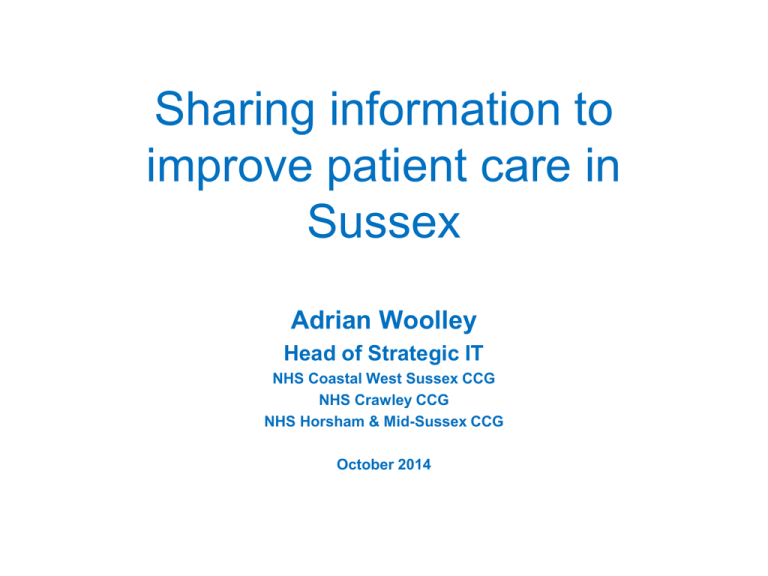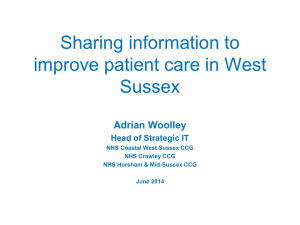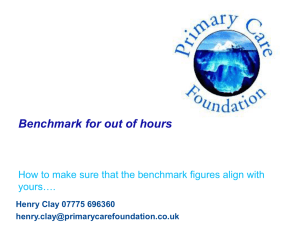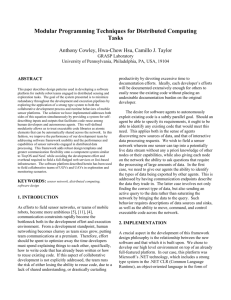Adrian Woolley - Health Insights
advertisement

Sharing information to improve patient care in Sussex Adrian Woolley Head of Strategic IT NHS Coastal West Sussex CCG NHS Crawley CCG NHS Horsham & Mid-Sussex CCG October 2014 Sharing information to improve communication & inform patient care Photo: sparkle glowplug The 15 million people in England with long term conditions… their treatment and care absorbs 70% of acute and primary care budgets in England. The barrier to great care for people with long term conditions… failure to provide integrated care Reactive services, not predictive services: failure to identify vulnerable people who might then be given extra help to avoid hospital admission or deterioration / complications of their condition… Fragmented care: the healthcare system…not being considered in a whole system approach with social care… Lack of informational continuity: care records which can’t be accessed between settings... How we normally share information between health and social care Where to find latest background information and contact assessments Serious case reviews – ‘familiar failings’ • Poor communication between and within agencies • "Professional over optimism" • A lack of "professional curiosity" in questioning information • A lack of confidence among professionals in challenging parents and other professionals • A lack of analysis of information • Shortcomings in recording systems Care providers can have ‘silos’ of information held within their organisational boundaries GP practice system Hospitals Community Nursing Significant diagnosis DNACPR Admission Avoidance DES Care Plan ECG Diabetes clinic In-patient discharge letter Specialist nurse record Contingency Care Plan Mental Health Dementia nursing MH Crisis Plan Social Services Social Services visit daily Care providers can have ‘silos’ of information held within their organisational boundaries GP practice system Hospitals Community Nursing Significant diagnosis DNACPR Admission Avoidance DES Care Plan ECG Diabetes clinic In-patient discharge letter Specialist nurse record Contingency Care Plan Mental Health Dementia nursing MH Crisis Plan Social Services Social Services visit daily A real time Read Only viewer for use in direct patient Care, with Information derived from both Health and Social Care ROCI A Virtual Integrated Digital Care Record Live data (no data warehouse) Live data (no overnight updates) Consent to view at point of need Real time messaging to multiple systems – ‘send pertinent information for unscheduled care’ GP NHS No, Name, DoB Hospital Community Nursing Integration Engine and VIPER360 portal Mental Health RBAC Social Services Consent record for audit What data could be available? From GP (via MIG): a patient summary problems diagnoses medication (current, past and issues) risk and warnings procedures investigations blood pressure measurements encounters, admissions and referrals patient demographics From SCR: current meds allergies adverse reactions From Community Trust open referrals From Social Services: Main Address Current Address Placement Address Allocated Worker, Open/Closed Agency Providing Care Package Funded? Emergency Next of Kin details Does the Subject Have a Carer? Is the Subject a Carer? From Acute Trusts: recent admissions & discharges EDD From care plan repository: anticipatory care plans LC Live data from the GP clinical system Patient details Examinations Events Summary Investigations Problems Procedures Risks & warnings Potentially useful in admission avoidance Recent tests Biochemistry ECG Haematology Imaging Microbiology Cytology Others Physiology Urinalysis Case study • Mrs W is a 91 y.o. woman who has dementia. She lives with her family but they are normally out during the working day. Mrs W is quite deaf. She has a leaky heart valve and AF, she has oedema in legs; she has been reviewed by a cardiology consultant. She is diabetic. • Mrs W presses her emergency button when she feels a bit breathless and wants a hand getting out of her chair. An ambulance is dispatched. Scenario 1 • Ambulance crew have no background data but find a confused patient unable to remember what medication she is on. They undertake ECG and find it abnormal, they decide to convey her to A&E. • Mrs W waits on a trolley in A&E, confused and a bit frightened. • A&E have no background data on patient. 4 hour target looming. Decide to admit to MAU for blood tests and ECG Scenario 2 • Ambulance crew access anticipatory care plan and are reassured that her condition is not acute. They decide not to convey but advise the district nurse. Scenario 3 • Ambulance crew do convey, however A&E access the ROCI system to understand the medical history and admission to hospital is avoided. Qualitative benefits Admission Avoidance People, especially the frail elderly, can find hospital admission a frightening experience and would rather be treated in their own homes. Avoiding tests and medication If unscheduled care has access to primary care and social care information then this information can sometimes avoid repeating test or medication that have already been prescribed. As well as a cost saving, it avoids subjecting patients to test or medication that does not benefit their care. ROCI: Where have we got to on programme? • PIA and Information Sharing Agreement signed by WSCC and several GP practices • Trust Interface Engine (messaging technology) installed and operational. • All EMIS Web practices in H&MS signed up to supplying data (MIG). • Pull of MIG data through system tested and working. • Social Services record to include NHS numbers; monthly batch tracing to start. • Bid submitted to DH’s Integrated Digital care Fund partnering with SCT, 6 CCGs in Sussex , WSCC and ESCC. Supported by both Health & Wellbeing Boards. ROCI: Where have we got to – Princess Royal pilot? • Started pilot with consultant and registrar grades at PRH Emergency Room this month. Potential other applications of ROCI •Discharge planning / Alerting •Hospital in-reach •Planned Care •Duty social worker •Primary / secondary care interface Thank you adrian.woolley@nhs.net Photo: garryknight Challenges for this type of project •The classics – stakeholder engagement etc x n2. •Information Governance, legal opinion •Data access. Paternalism •Commercial self interest of system suppliers •Finding care plans •Waiting to test against Spine 2 One place to find care plans = reduced conveyance by ambulance. A&E (ROCI) Ambulance OOH GPs Data readers Sussex wide care plan database GP Admission Avoidance DES care plans Proactive Care Data sources EoLC Plans











